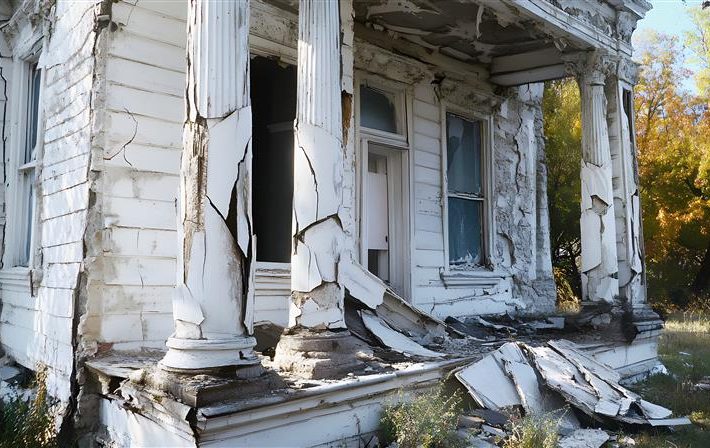How to Cope With Your First Damaged Section of Your House

Last year, I found myself in the middle of a crisis when I saw a bulge on the walls of my very first house that I bought. And needless to say, I started searching for how to fix structural damage to a house.
I am pretty sure that I am not the only one who faced a situation like this. For first-time homeowners, discovering damage to your home for the first time can be overwhelming and stressful.
Therefore, knowing how to approach the situation is critical, whether due to a natural disaster, an accident, or unforeseen issues like water leaks.
Additionally, acting quickly and effectively can minimize further damage, reduce costs, and help you regain a sense of normalcy.
However, I know that it is easier said than done! This is why I am here to help you with some of the easiest ways in which you can fix structural damage to your house!
But before we begin, let me tell you what structural damage is in the first place! So, without further ado, let us start with this guide, shall we?
Understanding Structural Damage
If you have bought your first house, you must have an idea about the fact that every house has a framework.
Structural damage to a house refers to any damage that weakens the structural integrity of the house. These can be to the roofs, the floor, or even walls.
Some of the major causes of structural damage that exists are:
- Age
- Lack of or improper waterproofing
- Poor construction
- Termites and ants.
I know how to fix structural damage to a house because I did it successfully. However, I would also like to point out that the structural damage that plagued my house was mainly related to water. Hence, that is exactly what I will focus on in this article.
How to Fix Structural Damage to a House: Step-by-Step Guide for Beginners!
Structural damage to a house due to water damage refers to the harm inflicted on the building’s framework and materials due to water intrusion. This can occur from leaks, floods, or poor drainage, leading to issues such as:
- Wood Rot: Prolonged exposure to moisture causes wooden structures to decay, weakening their integrity.
- Mold Growth: Damp environments promote mold, compromising health and structural stability.
- Foundation Issues: Excess water can erode the soil around foundations, causing settling or cracking.
- Wall and Ceiling Damage: Water can saturate drywall and insulation, leading to sagging or collapse.
Addressing water damage promptly is crucial to prevent these structural issues and maintain a safe living environment.
Here’s a step-by-step guide to coping with the first damaged section of your house, focusing on water damage as a common issue.
Assess the Damage
First, carefully inspect the damaged area. Make sure the damage is isolated and determine the extent of the problem.
Look for visible signs of water damage, such as discoloration, peeling paint, wall or floor swelling, and mold.
If the damage is extensive or you believe it poses a safety risk, it may be best to vacate the affected area until it can be addressed.
Prioritize Safety
Before addressing the damage, ensure the safety of your household. It is important that you turn off the main water damage so that you are able to prevent further flooding in cases of water damage!
Additionally, it would be best if you also switch off the. In this way, you will be able to avoid any kind of electrical hazards. If you notice mold, wear protective gear like gloves and masks. The same applies to sewage.
Take Immediate Action
Once the area is safe to enter, take the following steps to prevent further damage:
- Remove Standing Water: Use mops, buckets, or even a wet/dry vacuum to extract as much water as possible. For significant flooding, consider hiring professional water extraction services.
- Dry Out the Area: To accelerate drying, use fans, dehumidifiers, and open windows. Time is of the essence, as prolonged moisture can lead to mold growth.
- Document the Damage: Take a few moments to take clear photos and videos of the affected area from multiple angles. This documentation will be crucial when filing an insurance claim.
Contact Your Insurance Provider
If you have homeowners insurance, now’s the time to contact your provider. Explain the situation and inquire about your policy’s coverage for the type of damage sustained.
Many policies have specific clauses or exclusions for water damage, so understanding your coverage is essential.
| Expert Tip: Navigating the insurance claims process can be complex, particularly if you’ve never done it before. Consider consulting with professionals specializing in insurance claims for water damage, such as https://pcla.co.uk/. They can guide you through the claims process, ensuring you receive fair compensation. |
Decide on Repairs
After filing your claim, assess whether you’ll handle repairs or hire professionals. For water damage, it’s often advisable to work with experienced contractors who can:
- Thoroughly dry and sanitize the area.
- Repair or replace damaged structural components.
- Address any mold issues to prevent recurrence.
Prevent Future Damage
Once repairs are complete, you’ll want to reduce the risk of similar damage in the future. Regularly inspect plumbing and appliances for leaks.
Install a sump pump or backwater valve, seal basements, and improve drainage around your home. Remember to keep your gutters and downspouts clear, as this can prevent water accumulation.
One Section at a Time!
Dealing with a damaged section of your house for the first time can feel daunting, but with a clear plan, you can handle the situation effectively.
Assess the damage, prioritize safety, and act quickly to prevent further issues. Don’t hesitate to seek professional assistance for repairs and insurance claims.
Read Also:











Leave A Reply